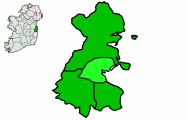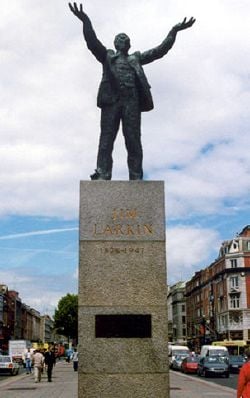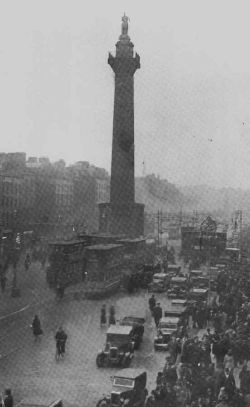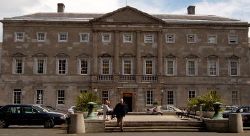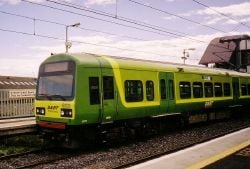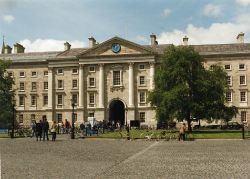Difference between revisions of "Dublin" - New World Encyclopedia
Mike Butler (talk | contribs) |
Mike Butler (talk | contribs) |
||
| Line 119: | Line 119: | ||
== Culture == | == Culture == | ||
[[Image:Joyce oconnell dublin.jpg|thumb|upright|Statue of [[James Joyce]] on North Earl Street, Dublin.]] | [[Image:Joyce oconnell dublin.jpg|thumb|upright|Statue of [[James Joyce]] on North Earl Street, Dublin.]] | ||
| − | |||
| − | |||
| − | |||
| − | |||
| − | |||
| − | |||
| − | |||
| − | |||
| − | |||
| − | |||
| − | |||
| − | |||
| − | |||
| − | |||
| − | |||
| − | |||
| − | |||
| − | |||
| − | |||
| − | |||
| − | |||
| − | |||
| − | |||
| − | |||
| − | |||
| − | |||
| − | |||
| − | |||
| − | |||
| − | |||
| − | |||
| − | |||
| − | |||
| − | |||
| − | |||
| − | |||
| − | |||
| − | |||
| − | |||
| − | |||
| − | |||
| − | |||
| − | |||
| − | |||
| − | |||
| − | |||
| − | |||
| − | |||
| − | |||
== Footnotes == | == Footnotes == | ||
Revision as of 02:33, 16 September 2008
| Dublin Baile Átha Cliath | ||

| ||
|---|---|---|
| Obedientia Civium Urbis Felicitas Latin: literally, "The citizens' obedience is the city's happiness" (rendered more loosely as "Happy the city where citizens obey" by the council itself)[1] | ||
| Location | ||
|
| ||
|
WGS-84 (GPS) Coordinates: | ||
| Statistics | ||
| Province: | Leinster | |
| County: | County Dublin | |
| Dáil Éireann: | Dublin Central, Dublin North Central, Dublin North East, Dublin North West, Dublin South Central, Dublin South East, Dún Laoghaire and Rathdown | |
| European Parliament: | Dublin | |
| Dialling code: | +353 1 | |
| Postal district(s): | D1-24, D6W | |
| Area: | 114.99 km² (44 sq mi) | |
| Population (2006) | Dublin City: 505,739 Dublin Urban Area: 1,045,769 Dublin Region: 1,186,821 Greater Dublin Area: 1,661,185[2] | |
| Website: www.dublincity.ie | ||
Dublin (pronounced /ˈdʌblɨn/, /ˈdʊblɨn/, or /ˈdʊbəlɪn/, Irish: Baile Átha Cliath, meaning Town of the Hurdled Ford,[3] pronounced [bˠalʲə aːha klʲiəh] or [bˠɫaː cliə(ɸ)]) is both the largest city and capital of Ireland. Founded as a Viking settlement, the city has been Ireland's primary city for most of the island's history since medieval times. Today, it is an economic, administrative and cultural centre for the island of Ireland and has one of the fastest growing populations of any European capital city.[4][5]
Geography
The name Dublin derives from 'Dubh Linn' (Irish, dubh -> black, and linn -> pool). The Dubh Linn was a lake used by the Vikings to moor their ships and was connected to the Liffey by the Poddle. The Dubh Linn and Poddle were covered during the early 1800s. The common name for the city in modern Irish is 'Baile Átha Cliath' ('The Settlement of the Ford of the Reed Hurdles'). 'Áth Cliath' is a place-name referring to a fording point of the Liffey in the vicinity of Heuston Station.
Located near the midpoint of Ireland's east coast, on a hill-ringed plain, in a beautiful bay, Dublin straddles the River Liffey, into which dark bog water drains, creating the “black pool”, which is the city's name.
Dublin enjoys a maritime temperate climate characterised by mild winters, cool summers, and a lack of temperature extremes. The average maximum January temperature is 46°F (8°C), the average maximum July temperature is 68°F (20°C). The sunniest months are May and June. Severe winds are most likely during mid-winter. The wettest months are December and August, with 2.9 inches (74mm) of rain. The driest month is April, with 1.77 inches (45mm). The total average annual rainfall (and other forms of precipitation) is 30 inches (762mm).
The city covers a land area of 44 square miles (114.99 square kilometers).
A north-south division has existed in Dublin for some time, with the dividing line being the River Liffey. The Northside is seen by some as working-class (with the exception of a few suburbs such as Howth, Malahide, Portmarnock, Clontarf and Sutton) while the Southside is seen as middle and upper middle class (with the exception of a few "working-class" suburbs such as Ballinteer, Sallynoggin, Crumlin, Drimnagh, Inchicore, Ballyfermot, Palmerstown, Neilstown and Tallaght). Traditionally it was a working class divide which began at Dublin docks in the early 1900s where, depending which side of the Liffey a boat docked, the dockers on that side got a day's work while those on the other side went home.
History
The writings of the Greek astronomer and cartographer Ptolemy provide perhaps the earliest reference to human habitat in the area now known as Dublin. In around 140 C.E., he referred to a settlement he called Eblana Civitas. The settlement 'Dubh Linn' dates perhaps as far back as the first century B.C.E. and later a monastery was built there, though the town was established in about 841[6] by the Norse.
The subsequent Viking settlement was on the River Poddle, a tributary of the Liffey, to the East of Christchurch, in the area known as Wood Quay. The Dubh Linn was situated where the Castle Garden is now located, opposite the Chester Beatty Library in Dublin Castle.
The modern city retains the Anglicised Irish name of the former and the original Irish name of the latter. After the Norman invasion of Ireland, Dublin became the key centre of military and judicial power, with much of the power centering on Dublin Castle until independence. From the 14th to late 16th centuries Dublin and the surrounding area, known as the Pale, formed the largest area of Ireland under government control. The Parliament was located in Drogheda for several centuries, but was switched permanently to Dublin after Henry VII conquered the County Kildare in 1504.
Dublin also had local city administration via its Corporation from the Middle Ages. This represented the city's guild-based oligarchy until it was reformed in the 1840s on increasingly democratic lines.
From the 17th century the city expanded rapidly, helped by the Wide Streets Commission. Georgian Dublin was, for a short time, the second city of the British Empire after London and the fifth largest European city. Much of Dublin's most notable architecture dates from this time and is considered a golden era for the city. The famous Guinness brewery was also established at this time too. In 1742, Handel's "Messiah" was performed for the first time in New Musick Hall in Fishamble St with 26 boys and five men from the combined choirs of St.Patrick's and Christ Church cathedrals participating.
The 1800s, with the seat of government moving to Westminster, were a period of decline relative to the industrial growth of Belfast. By 1900, the population of Belfast was nearly twice as large. Whereas Belfast was prosperous and industrial, Dublin had become a city of squalor and class division, built on the remains of lost grandeur, as best described in the novel Strumpet City, by James Plunkett, and in the works of Sean O'Casey.
Dublin was still the primary centre of administration and transport for much of Ireland, though completely bypassed by the Industrial revolution. The Easter Rising of 1916 occurred in the city centre, bringing much physical destruction. The Anglo-Irish War (1919 to 1921) and Irish Civil War (1922-1923) contributed even more destruction, leaving many of its finest buildings in ruins. The Irish Free State rebuilt many of the buildings and moved parliament to Leinster House.
Through The Emergency during World War II (1939-1945), when Ireland was officially neutral, until the 1960s, Dublin remained a capital out of time: the city centre in particular remained at an architectural standstill. This made the city ideal for historical film production, with many productions including The Blue Max, and My Left Foot capturing the cityscape in this period. This became the foundation of later successes in cinematography and film-making.
With increasing prosperity, modern architecture was introduced to the city, though a vigorous campaign started in parallel to restore the Georgian greatness of Dublin's streets, rather than lose the grandeur forever. Since 1997, the landscape of Dublin has changed immensely, with enormous private and state development of housing, transport, and business. (See also Development and Preservation in Dublin). Some well-known Dublin street corners are still named for the pub or business which used to occupy the site before closure or redevelopment.
Since the beginning of Anglo-Norman rule in the 12th century, the city has served as the capital of the island of Ireland in the varying geopolitical entities:
- the Lordship of Ireland (1171–1541)
- the Kingdom of Ireland (1541–1800)
- the island as part of the United Kingdom of Great Britain and Ireland (1801–1922)
- the Irish Republic (1919–1922).
From 1922, following the partition of Ireland, it became the capital of the Irish Free State (1922–1949) and now is the capital of the Republic of Ireland. One of the memorials to commemorate that time is the Garden of Remembrance.
In a 2003 European-wide survey by the BBC, questioning 11,200 residents of 112 urban and rural areas, Dublin was the best capital city in Europe to live in.[7]
A person from either the city or county of Dublin is often referred to as a "Dub".
Government
Ireland is a republic, and a parliamentary democracy, which is based in Dublin. The president, who is chief of state, is elected by popular vote for a seven-year term, and is eligible for a second term. The prime minister, (taoiseach) who is head of government, is nominated by the House of Representatives and appointed by the president.
The bicameral parliament, or Oireachtas, consists of the senate or Seanad Eireann of 60 seats, with 49 members elected by the universities and from candidates put forward by five vocational panels, and 11 nominated by the prime minister, to serve five-year terms. The House of Representatives, or Dail Eireann, has 166 seats, the members of which are elected by popular vote on the basis of proportional representation to serve five-year terms.
The City Council is a unicameral assembly of 52 members, elected every five years from Local Election Areas. The party with the majority of seats decides who sits on what committee, what policies are followed, and who becomes Lord Mayor. Chaired by the Lord Mayor, the Council passes an annual budget for spending on housing, traffic management, refuse, drainage, planning, etc. The Dublin City Manager is responsible for the implementation of decisions of the City Council.
The City of Dublin is the area administered by Dublin City Council, but the term normally refers to the contiguous urban area which includes the adjacent local authority areas of Dun Laoghaire-Rathdown, Fingal and South Dublin. Together the four areas form the traditional County Dublin. This area is sometimes known as 'Urban Dublin' or the 'Dublin Metropolitan Area'.
Economy
Ireland is a small, modern, trade-dependent economy with growth averaging six percent in the 1995-2007 period. Agriculture, once the most important sector, is now dwarfed by industry and services. Although the exports sector, dominated by foreign multinationals, remains a key component of Ireland's economy, construction has most recently fueled economic growth along with strong consumer spending and business investment.
Dublin has been at the centre of Ireland's phenomenal economic growth over the last 10-15 years, a period (often of double-digit growth) referred to as the Celtic Tiger years. Living standards in the city have risen dramatically, although the cost of living has also soared. In 2008, Dublin was listed as the fifth-richest city in the world[8]. According to one source, Dublin is now the planet's 16th most expensive city (8th most expensive city in Europe, excluding Russian cities).[9] It was also listed as the third most expensive city in the world in which to live.[10]However, it has the second highest wages for a city in the world, ahead of both New York City and London, though behind Zürich.[11]
In 2005, around 800,000 people were employed in the Greater Dublin Area, of whom around 600,000 were employed in the services sector and 200,000 in the industrial sector.[12] Dublin is one of the constituent cities in the Dublin-Belfast corridor region which has a population of just under 3 million. Per capita GDP for Ireland was estimated at $43,100 in 2007.
Banking, finance and commerce are also important in the city - the IFSC alone handles over €1 trillion a year. Many international firms have established major headquarters in the city (eg. Citibank, Commerzbank). Also located in Dublin is the Irish Stock Exchange (ISEQ), Internet Neutral Exchange (INEX) and Irish Enterprise Exchange (IEX).
The economic boom years have led to a sharp increase in construction, which is now also a major employer, though, as of 2007, unemployment is on the rise as the housing market has begun to see supply outstrip demand. Redevelopment is taking place in large projects such as Dublin Docklands, Spencer Dock and others, transforming once run-down industrial areas in the city centre. Dublin City Council seems to now have loosened the former restrictions on "high-rise" structures. The tallest building, Liberty Hall, is only 59.4 m (194.9 ft) tall; already under construction in the city is Heuston Gate, a 117 m (384 ft) building (134 m including spire). The 120 m (394 ft) Britain Quay Tower and the 120 m (394 ft)
Historically, brewing has probably been the industry most often associated with the city: Guinness has been brewed at the St. James's Gate Brewery since 1759. Since the advent of the Celtic Tiger years, however, a large number of global pharmaceutical, information and communications technology companies have located in Dublin and the Greater Dublin Area. For example, Microsoft, Google, Amazon, PayPal, Yahoo! and Pfizer (among others) now have European headquarters and/or operational bases in the city and its suburbs. Intel and Hewlett-Packard have large manufacturing plants in Leixlip, County Kildare, 15 km (9 mi) to the west. Transport: Road, rail, air, sea
Dublin is also the main hub of the country's road network. The M50 motorway, a semi-ring road, connects the most important national primary routes that fan out from the capital to the regions. Dublin is served by an extensive network of nearly 200 bus routes. The Dublin Suburban Rail network is a system of five rail lines serving commuters in the Greater Dublin Area, though some trains go to Drogheda and Dundalk, including an electrified line known as the Dublin Area Rapid Transit (DART) line that runs along Dublin Bay. A two-line light rail/tram network called the Luas opened in 2004. A subway was planned in 2005. Dublin Port is the country's busiest sea port and Dublin Airport is the busiest airport on the island.
Demographics
The population of the administrative area controlled by the City Council was 505,739 at the census of 2006, while the County Dublin population was 1,186,159, and that of the Greater Dublin Area 1,661,185. The city's population is expanding rapidly, and it is estimated by the CSO that it will reach 2.1 million by 2021. Today, approximately 40 percent of the population of the Republic of Ireland live within a 100 km (62 mi) radius of the city centre.[13]
Dublin has a long history of emigration that continued into the early 1990s. Since then there has been net immigration and Dublin now has a significant population of immigrants. Foreign nationals in the city are primarily young and single[14] and the greatest numbers come from the European Union, especially the United Kingdom, Poland and Lithuania. There is also a considerable number from outside Europe, particularly China, Nigeria, Brazil, Australia, New Zealand and Russia.
A total 87.4 percent of Ireland's population in 2006 was recorded as Irish, 7.5 percent were "other white", while 1.1 percent had a "black or black Irish" background, 1.1 percent were mixed, and 1.6 percent were unspecified.
The official languages are Irish and English, although the latter is by far the predominant language spoken throughout the country.
The Republic of Ireland is 86.8 percent Roman Catholic, and has one of the highest rates of regular and weekly church attendance in the Western World, although this has declined over the past 30 years. Immigration has increased Dublin's religious diversity, with increasing numbers of Protestants and Muslims.
Official statistics from An Garda Síochána for 2001-2005[15] show that the overall headline crime rate for the metropolitan area per 1000 of population is the highest in the country. During the 1980s and 1990s, a heroin epidemic swept through working class areas of the inner city and outlying suburbs. As of September 2008, there has been 14 homicides in which 13 were gang-related gun murders.
Dublin is the primary centre of education in Ireland, with three universities and several other higher education institutions. There are 20 third-level institutes in the city.[16] The University of Dublin is the oldest university in Ireland dating from the 16th century. Its sole constituent college, Trinity College, was established by Royal Charter under Elizabeth I. The National University of Ireland has its seat in Dublin, which is also the location of the associated constituent university of University College Dublin, the largest university in Ireland. Dublin City University (DCU) is the most recent university and specialises in business, engineering, and science courses, particularly with relevance to industry.
Culture

Footnotes
- ↑ Dublin City Council Dublin City Coat of Arms (retrieved 16 February 2007
- ↑ Central Statistics Office 2006
- ↑ 'Baile Átha Cliath' (or simply 'Áth Cliath') and 'Dubh Linn' are the two names of the city, the former being the one currently in official and common usage.
- ↑ TalkingCities
- ↑ The Irish Experience
- ↑ A Popular History of Ireland - Thomas D'Arcy McGee (1825-1868)
- ↑ BBC record of Survey
- ↑ City Mayors - The world's richest cities by purchasing power in 2008
- ↑ Global/Worldwide Cost of Living Survey Rankings 2007/2008, Cities, International, Europe 2007
- ↑ City Mayors - The world's most expensive cities in 2008
- ↑ London is the most expensive city in the world while Swiss cities are home to highest earners
- ↑
 PDF
PDF
- ↑ Call for improved infrastructure for Dublin 2 April 2007
- ↑ Most new immigrants young and single July 12, 2007
- ↑ Garda Annual Reports 1999-2006
- ↑ Dublin facts
See also
- Christ Church Cathedral, Dublin
Further reading
- Pat Liddy, Dublin A Celebration - From the 1st to the 21st century (Dublin City Council, 2000) (ISBN 0-946841-50-0)
- Maurice Craig, The Architecture of Ireland from the Earliest Times to 1880 (Batsford, Paperback edition 1989) (ISBN 0-7134-2587-3)
- Frank McDonald, Saving the City: How to Halt the Destruction of Dublin (Tomar Publishing, 1989) (ISBN 1-871793-03-3)
- Edward McParland, Public Architecture in Ireland 1680–1760 (Yale University Press, 2001) (ISBN 0-300-09064-1
- Hanne Hem, Dubliners, An Anthropologist's Account, Oslo, 1994
- John Flynn and Jerry Kelleher, Dublin Journeys in America (High Table Publishing, 2003) (ISBN 0-9544694-1-0)
External links
- Travel guide to Dublin from Wikitravel
- Dublin Tourist Board - Official website
- Dublin City Council - Official website
- Portal for Dublin - Dublin.ie (supported by Dublin City Council)
- Architecture of Dublin - IrishArchitecture.com
- Chapters of Dublin - Site with original text of books on Dublin history
Credits
New World Encyclopedia writers and editors rewrote and completed the Wikipedia article in accordance with New World Encyclopedia standards. This article abides by terms of the Creative Commons CC-by-sa 3.0 License (CC-by-sa), which may be used and disseminated with proper attribution. Credit is due under the terms of this license that can reference both the New World Encyclopedia contributors and the selfless volunteer contributors of the Wikimedia Foundation. To cite this article click here for a list of acceptable citing formats.The history of earlier contributions by wikipedians is accessible to researchers here:
The history of this article since it was imported to New World Encyclopedia:
Note: Some restrictions may apply to use of individual images which are separately licensed.
